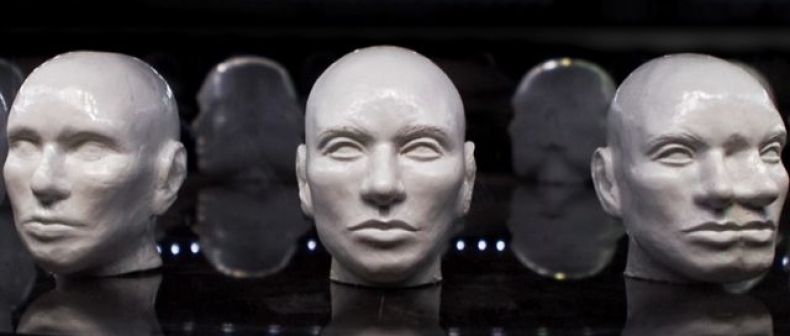
Xhensila Zemblaku’s Daedalum (2012)
I was unsure of what to expect when entering InterAccess Electronic Media Arts Centre‘s annual emerging artist exhibition. This year’s iteration is titled Corpus Lucida, and I wondered whether or not I would be walking into a kind of exquisite corpse of a show; the kind of all-over hodgepodge with work by a bucketful of artists. Curated by Farah Yusuf, the show is spare and tasteful, highlighting the work of five artists, all very recent graduates of BFA programs (most of them hail from OCAD, with one noted exception).
The title of course has nothing to do with corpses, exquisite or otherwise, although it does have much to do with bodies. According to Yusuf’s curatorial essay, the title (“the illuminated body”) is meant to stand in contrast to the camera obscura. The latter was the 17th-century prototype of the camera: a darkened chamber with a small hole, which projected a mirrored version of the outside world onto its interior surface. A drawing aid and a progenitor of point-based perspective, it parsed the world according to sight: a claim to objectivity through optics. In collecting these artists, Yusuf seeks to shift that focus from visual perception to sensory perception; she collects work that uses the eye as a gateway to the body.
As with most conceptually driven shows, much of the work is entirely inaccessible without didactic material. These are all new- and electronic-media-based works, and their conceptual intent has just as much to do with the construction and execution as it does with the transparent legibility of any kind of final product. In some cases, a guided tour deepens the work; in some cases, it provides nothing but trivia.
Omar Elkharadly’s Allegory takes as its starting point (according to Yusuf) the allegory of Plato’s Cave, of poor souls doomed to watch a shadow version of the world play itself out. The installation consists of a woven lampshade illuminated by two projectors; when the installation is “activated” by turning on the lampshade (and donning 3D glasses), the object is subjected to a kind of live stereoscopic treatment — it becomes “3D”. It’s a neat trick, but one that leaves me unsure of whether or not Elkharadly actually understands Plato’s allegory; for Plato, the shadows on the wall were our reality, in comparison to the world of ideal forms. Is Elkahady trying to suggest that 3D glasses and optical trickery are our ticket to a higher plane? Moreover, despite what one thinks of the fruitfulness of interrogating Plato in the 21st century, the installation seems to me to gild the lily; after all, even without the stereoscopic specs, the lampshade already exists in three dimensions.
Aamna Muzaffar’s miniature sculptures — 24 Jogs — are sweet and spare. Colourful and blocky, they straddle representation and abstraction: some look like geometricized animals (a snail, a cat), some like palm-sized architectural models. They were made with a 3D rendering smartphone app, and were apparently designed during walking breaks on a series of exercise jogs. The jog aspect adds little to the appreciation of the work, but the idea that these were all designed on a smartphone introduces a kind of creepiness to the work that is at once twee and megalomaniacal: it explains their kid’s-toy scale, and suggests a world suited to fit in the palm of our hands, a smartphone-designed Lilliput where the designer is deity.
Lanie Chalmers’ I Don’t Owe You Anything consists of two videos installed in the far corner of the gallery. The artist stares at us alternately from above and below, simultaneously supplicant and domineering. The piece suffers from its installation; these videos, in order to communicate the kind of affective negotiation that Chalmers intends, need to fill a room. Here, it’s just a couple of projections in a corner, the over-simplicity of the concept unfortunately highlighted by the diminutive scale.
The best works in the show are the two corner installations: Kyle Duffield’s Chromastrobe and Xhensila Zemblaku’s Daedalum. The latter is a kind of sculptural zoetrope; a calliope of heads spins furiously, each one appearing to collapse in on itself. It’s an exciting play on Muybridge. Just as he announced the potential of photography, and the kind of perceptual illusions it could harness, Zemblaku’s installation — a three-dimensional animation completely independent of photography or internal robotics — has the same kind of brave-new-world feel.
Chromastrobe is a kind of variant on a flicker film: a flat projection fills the room, rapidly cycling through red, green, and blue. It’s intensely jarring: the frame rate is so fast that, initially, the viewer experiences the projection as a tic-y white screen. As you become accustomed to the flickering, all of a sudden, shapes appear: abstract forms that swirl and spread in fogs of electric Kool-Aid colours. The longer you stare, the more the visuals seem to embed themselves in your eyes. Of course, nothing different is being projected on screen; these shapes are a product of your haplessly confused retinae and brain as they try frantically to keep up with the visual onslaught of the projection. In the end, this is the truest iteration of Yusuf’s curatorial concept, and the most exciting intimation of its possibilities: the art of Duffield’s strobe is not extrinsic — it’s not something external to be passively looked at. It’s neural; it’s reaching through your eye into your brain. The art happens quite literally inside you.
Corpus Lucida continues at InterAccess Electronic Media Arts Centre until August 18.
______
Sholem Krishtalka is the Toronto Standard’s art critic.
For more, follow us on Twitter at @torontostandard, and subscribe to our newsletter.











